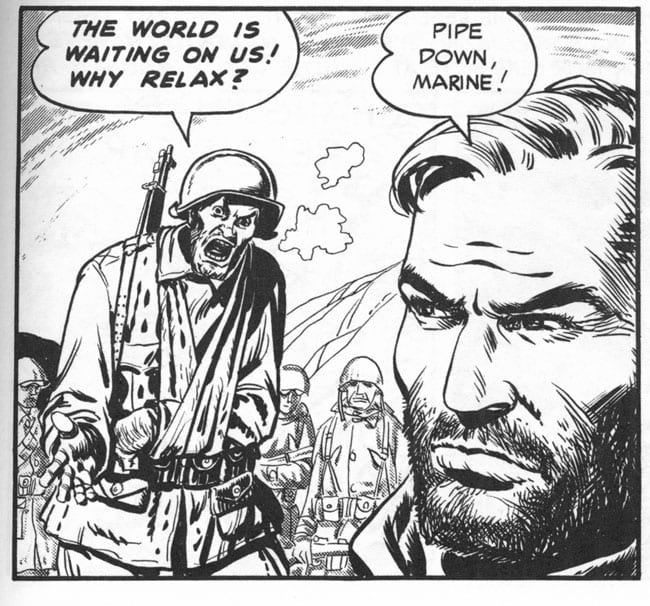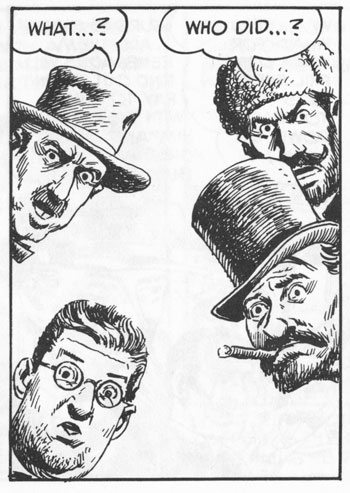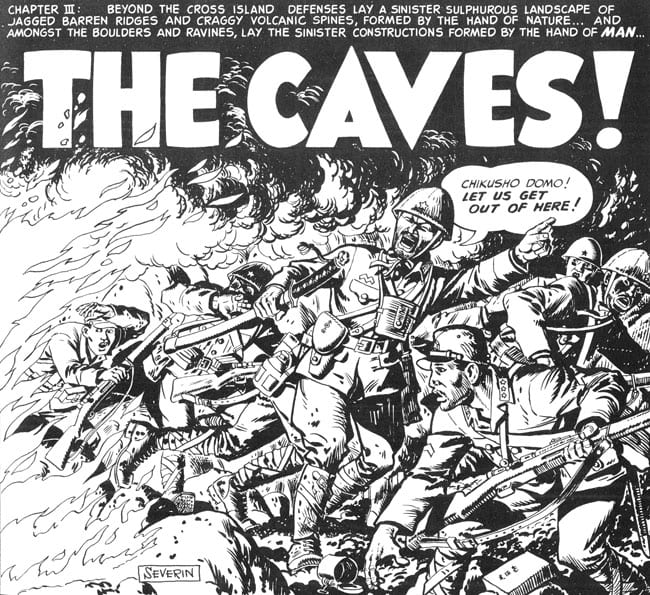EARLY INFLUENCES
GROTH: In your teenage years, during the High School of Music and Art, what kind of artists were you looking at and discovering? Can you put yourself back in there and try to remember these details I’m trying to glean from you?
SEVERIN: I understand what you're getting at.
GROTH: I’m looking for your evolution in terms or who you discovered and how you moved from one artist to another.

SEVERIN: My evolution was like real evolution—haphazard as all hell! On one hand, I would latch onto a Monet, and on the other hand, I'm looking at some guy—I'm trying to remember—his last name was Abbey, A-B-B-E-Y, and he had three names, the middle one being long. And he did these unbelievable, magnificent, and gigantic paintings of Arthurian scenes, would be a good example. There was a museum uptown New York that had a display of his art for, my goodness, I think it was for a whole year! Anyhow, somebody with detail work that would rival the Renaissance painters. Then, the next thing you know, I would be going down into the paintings and drawings of another guy, who, by the way, influenced me quite a bit, Charles Marion Russell, the cowboy artist. I'd go for him, swing over to Heinrich Kley. It just bounced around. So as I say, my evolution was sort of haphazard. It was the way the real McCoy occurred!
GROTH: It sounds like a rich tapestry of artists you kept stumbling on.
SEVERIN: You make it sound much more colorful.
GROTH: Well, that's my job. You once said that one of the things that sparked your interest in history, and specifically history of the American West, were cowboy movies. Can you tell me a little about when you started movie-going?
SEVERIN: I can tell you the first movie I ever saw, but I can't remember when I started going to the movies regularly, because it started rather early. By the way, the first movie I ever saw was Wings. My parents brought me to see that.
GROTH: Who was in Wings?
SEVERIN: Gary Cooper, Richard Arlin, Buddy Rogers, and...who the hell was the girl? There's always a girl. But she was, in a Western, sort of unimportant. We didn't pay attention to girls much...well, not too much. I would say, when I was in grammar school, I started collecting coke bottles and tin foil from cigarette packs, and when the junk man came around every week I'd sell it to him and end up with enough money to go to the movies. All you needed was a dime.
GROTH: So that would have been somewhere in the neighborhood of 1930?
SEVERIN: Yeah. And it was mostly, naturally, double features, and one of them was bound to be a Western.
GROTH: I assume you came to love Westerns?
SEVERIN: Absolutely. I've got almost a complete collection of John Wayne’s.
GROTH: Does it matter who directed it, or is it just John Wayne that you're...

SEVERIN: No. Sometimes it does. If somebody asks, "Which are the better John Wayne’s?" the ones that I'll name are the ones that were directed properly. Most of them are sophisticated old Westerns, if you disregard his early stuff.
GROTH: Because there are better and worse John Wayne movies.
SEVERIN: Yes, there are. [Laughter.] There are some clinkers in there.
THE COLOR OF WAR
GROTH: You graduated from the High School of Music and Art, you must have been 17 or 18 when you graduated?
SEVERIN: Actually, I was 19.
GROTH: You were 19, because of that extra year you mentioned?
SEVERIN: Not only that, but when I transferred to my schools from Long Island to Brooklyn, I stayed behind a half a year—for what reason, I'm lost. It isn't terribly important for your story, but for your personal information, that's part of the time element. Most of it was—you were right—taken up by the fact that I lost a whole year at St. John's.
GROTH: So you were 19, and that would have placed you somewhere around 1940, I think.
SEVERIN: Maybe that's when I got out? Yeah. That's good. Nineteen-forty.
GROTH: Now you went into the service in '41?
SEVERIN: No. In '42. I worked for the A.C. Sparkplug Company, making 20 millimeter shells for the British and the French Airforce.
GROTH: You got that job right out of high school?
SEVERIN: Not long after. I depended for a short while on The Hobo News. Some guy, I think it was a friend of my father's, told him that they were looking for help over in Long Island City. I went over there and got the job, and made shells until I decided to join the army.
GROTH: So you were a volunteer? You didn't get drafted?
SEVERIN: No. I was a volunteer.
GROTH: Why didn't you seek a job drawing or cartooning out of high school?
SEVERIN: I have no idea. As I tell you, my evolution was a true evolution. It bounced all over. Whatever came along, I just adapted to it. Some guy offered a job that sounded good, I'd take it. My drawing was just part of me.
GROTH: You weren't quite aware of that.
SEVERIN: You'd think after going through high school and the preparation they gave us there it would come to me, but I never was especially bright.
GROTH: I see. Well, we'll take that with a grain of salt.
SEVERIN: Thanks.
GROTH: Can you tell me a little about your stint in the Army? Did you serve in the European theatre?
SEVERIN: No. I went to the Pacific. I don't know how long or short that you want to make this. So much of this stuff has been done before. I feel that it's been done before, but I'll give it all to you and you can take whatever you want out of it.

GROTH: Can you tell me a little about your introduction to the Army? Did you take easily to Army life?
SEVERIN: Oh, absolutely. It was the way to go, until you had enough of it, and then there was another way to go—out! [Guffaws.] I joined up down on 39 Whitehall Street, down at the recruiting station in New York. Then I went over to Fort Dix. From Fort Dix they decided that they needed Air Corps people, so they sent me down to Mississippi, Mississippi sent me to Alabama. To make a long story short, I eventually ended up in South Dakota, where I was trained to be a radio operator and mechanic on a bomber. I didn't care for that idea very much, because I would much rather work a machine gun than to sit around playing with a radio. Besides, I was rather large for the planes in those days. So it wasn't too difficult, after I graduated from that place, to try to get in as a gunner. But again, my height was against me there. So they ended me up—because in between I tried to fly a plane, be a pilot, and pass the tests. Is it permissible to brag?
Because part of the brag is a funny story, but it ends up brag, and I don't like that part of it. I'll tell it to you, and you can tone it down. Every three months they would change the test, and you could only take the test in that core area once in that three-month period, so there was no chance of somebody keeping the notes in the test, because you had completely new test the next time you took it. I came in blasted and took the test—and I mean I was blasted—and I got the highest marks in that core area in that three-month period! [Laughs.] I don't know how the hell I did it, but that's what happened.
So they said, "Oh, this is fine." They called me out one day and I had to go down and take the physical for the air cadet, and passed that just Jim-dandy fine. Except when they came to the eye test, I was found to be color-blind. So they took me out in the sunshine and gave me the test, and it didn't work. They took me in under fluorescent lights and it didn't work then. Nothing! Of course, they're not going to waste thousands of dollars on some cluck who is color-blind when they can get a perfectly fine guy right down the road. So I didn't make it. I ended up, as a result of going into the airborne... Since I was colorblind, they put me in the camouflage section, which was easygoing. What a life that was.
GROTH: Why was that so easy?
SEVERIN: You just camouflaged something, and then everybody stands around saying, "Isn't that grand?" And we'd have a beer, if somebody could swipe some, and next day we go out and we'd dig a silhouette of an airplane and we'd pour oil in the silhouette, and then somebody'd fly over and take photographs and see if it looked like a plane. Or they'd hide a bunch of guys in the weeds with camouflage, and we'd go through, and of course I could spot the guys. All but one guy. One guy did get away with it with me. But because I was colorblind—this was why they wanted me—I could spot the camouflage much easier than anybody else could. They used me as a determinant as to whether it was good or bad camouflage. That got boring as all hell!

GROTH: Where did you do this?
SEVERIN: Up in Massachusetts. Outside of Holyoke. What's the name of that field...?
GROTH: What exactly were you camouflaging?
SEVERIN: Anything. Just look at me. I'd camouflage you. People, gun emplacements, airplanes, tents, trucks, etc... The physical labor was nothing. There was a lot of sitting around. I liked that. That was good. [Laughter.] But there was a war going on, so I ended up transferring to heavy weapons. Sounds terrific, but heavy weapons doesn't go any further than the 37 millimeter tank gun. I trained guys from the 30-caliber machine gun, 50 anti-tank gun, bazooka... all this garbage. I don't know. One of these outfits that we trained went over to North Africa and got wiped out. The captain came back and... Well, to stop all the bull, I ended up disgusted. They were asking for machine gunners in some engineer outfit that was going overseas, so I decided, "Enough training. Let's get going with this crap!" And of all things, I became a machine gunner. I went with the engineers over to the Pacific, and we won the war. Everybody congratulated me, generals came forward and pinned medals on my chest, and thanked me for all that I had done, and I went home. Believe that and I'll tell you another!
GROTH: Did you see action over there?
SEVERIN: No, mine wasn't a combat troop. My action was minor stuff...raids, on their part of guarding... Since I was crew chief of the half-track, I guarded guys when they're out there working. Sometimes you'd get bored stiff and you'd volunteer and go on patrol of the area. Sometimes you'd help out the marines in their patrols, pad up their manpower. But as far as actual action...nah. Did I get shot at? Did I shoot at them? Everybody did. But I wasn't combat troop. Probably we wouldn't be here if...

GROTH: You got back, and I assume there was an enormous feeling of relief?
SEVERIN: No, not especially.
GROTH: No? Was there an enormous feeling of dread going into the Pacific Theatre?
SEVERIN: No. Whatever happens, happens. I'd have preferred to go to Europe.
GROTH: You'd have preferred to shoot Germans?
SEVERIN: Oh, much more so.
GROTH: I see. Now why is that?
SEVERIN: I don't like them. Put that in the script and I'll shoot you.
GROTH: l am of German heritage.
SEVERIN: I know that. Why do you think I worked it up to that point? You're lucky you weren't Japanese! No, I would have preferred to go to Europe for a lot of other things. I would have been familiar with the surroundings, the buildings...the people wear shoes. The Pacific, I knew nothing about, except that they had a lot of coconuts. This really interested me. I was devoted to coconuts.
GROTH: My impression was that people in the armed services were really wary of going to the Pacific Theatre because it was supposed to be more terrifying than a known quantity such as the European Theatre?
SEVERIN: I see what you mean, though that never occurred to me.
GROTH: And the idea of invading Japan, I think, was pretty terrifying.
SEVERIN: I don't know about terrifying, because if they [the Army brass] point you in that direction, that's the only direction to go. You can't be afraid of what you don't know. It's when you know something that you can be afraid of it. Then there's a reason for fear. I didn't know anything about Japan, whether they would put up a big fight. Now, of course, looking back, I realize they would have put up one hell of a fight, as anybody would, [with us] invading their country.
GROTH: They put up a fight with every island.
SEVERIN: Every island. A couple of typhoons whacked us on Okinawa, and here, the island was completely taken. We'd been there building air fields and all this kind of crap. These guys, after the typhoon, they'd come creeping out of the caves. My God, they're starving, they're hungry, the typhoon beat the crap out of them. We didn't know these guys were no more than maybe 200 feet away from us half the time. We didn't know these guys were that close, all this time.

GROTH: So there was not an immense feeling after the war ended? It was just...
SEVERIN: No. Rationally, I was aware that it was a good thing that the war was over and I was damn glad the damn Nazis had been beaten, and of course I was glad the Japs had been beaten, because they were the ones who were shooting in my direction. But getting back to civilian life... That was what you were supposed to do! You're out of the uniform. I almost decided to stay in for a while, then I said, "Well, no. Enough is enough. You can always go back." So I just returned to civilian life and tried to get on with whatever it was I was supposed to be doing.
GROTH: Did you move back home?
SEVERIN: Oh, yeah. In those days, people lived at home until they got married. Most people, anyhow.
GROTH: That would have been '45? Or '46?
SEVERIN: That would have been '46. I'll tell you one little thing that was great. My devotion to the dice did me well at the last. The guys who had enough points at any given time were grouped together and sent down to a beach. For what reason? I imagine because it's nearest to the boats, but I couldn't figure why they put us down on the beach, 200 feet from the water sloshing, absolutely desolate. But anyhow, they sent us down and so there was about maybe ten or 20 tents full of guys who were ready to take off. We got paid three months back pay. I was living with the regimental sergeant major and he left the tent after we got paid, and we started playing craps. I took the other four guys' complete pay...just wiped them out. He had similar luck. He went over to the Company C boys, and he took their money. So he came back, and everybody was laughing and telling us we'd cheated, and stuff like that. Then they started talking it up, and they dared us to get into a game together. So we did, and I took his money. That's the last time I've ever had any luck.

GROTH: I was going to say, it sounds like you could have had another career.
SEVERIN: Well, it was something. It was just good luck. That isn't necessary for the story. I just thought I'd throw that in.
GROTH: Well, a certain amount of color is good.
SEVERIN: By the way, that sergeant major still owes me 40 bucks. I had to lend him some money to go home.
GROTH; Well, if we print that and he sees it, maybe he'll send it to you.
SEVERIN: Hey! His name is Gallagher. [Laughs.]






